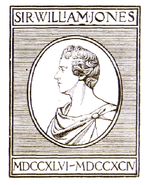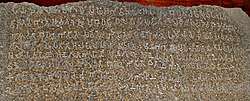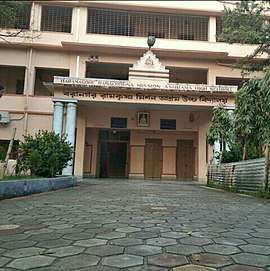The Asiatic Society
The Asiatic Society was founded by civil servant Sir William Jones on 15 January 1784 in a meeting presided over by Robert Chambers, Justice of the Supreme Court of Judicature at Fort William at the Fort William in Calcutta.
 | |
| Established | 1784 |
|---|---|
| Location | 1 Park Street Kolkata – 700016 West Bengal, India |
| Type | Library |
| President | Isha Mohammad |
| Website | asiaticsocietykolkata.org |
History
In January 1784 Sir William Jones sent out a circular-letter to a selected number of British residents of Calcutta with a view to establish a society for the Asiatic studies. At his invitation, thirty British residents met in the Grand Jury Room of the Supreme Court (in Calcutta's Fort William) on 15 January 1784. The meeting was presided over by Sir Robert Chambers. At this meeting, Jones explained the aims of the Society he would establish. The Memorandum of Articles of the Asiatic Society, prepared by Jones said:[1]
The bounds of investigations will be the geographical limits of Asia, and within these limits its enquiries will be extended to whatever is performed by man or produced by nature.
Notable early members were Charles Wilkins and Alexander Hamilton (the cousin of the American statesman). Initially, the Grand Jury Room of the Supreme Court was used for the meetings of the members, who had to pay a quarterly fee of two mohurs. The members were elected through ballot-voting. On 29 September 1796 the Society decided to have its own building. J.H. Harrington, then Vice-President selected the corner of Park Street and Chowringhee Road (present location) for the Society's house. The site was granted to the society on 15 May 1805. The original plan for the new building was prepared by Captain Thomas Preston. The French architect, Jean-Jacques Pichou[2] made certain modifications to it and constructed a two storeyed building at the site. This 15,071 ft² building was built at a cost of Rs. 30,000.00. The first quarterly meeting of the Society for 1808 was held at its new building on 3 February 1808.[1]
From 1784 to 1828, only Europeans were elected members of the Society. In 1829, at the initiative of H.H. Wilson, a number of Indians were elected members, which include Dwarakanath Tagore, Sivchandra Das, Maharaja Baidyanath Roy, Maharaja Bunwari Govind Roy, Raja Kalikrishna Bahadur, Rajchunder Das, Ram Comul Sen and Prasanna Coomar Tagore. On 12 December 1832 Ram Comul Sen was elected 'Native Secretary'. Later, Rajendralal Mitra became the first Indian President in 1885.[1] Both the orientalist, Brajendranath De, and one of his grandsons, the historian, Barun De, were for sometime vice president of the Asiatic Society.[3][4][5]
Library
One of the main activities of the Asiatic Society was to collect the old manuscripts of India.[6] There was an enormous collection of Sanskrit manuscripts with the society.[6] At present, the library of the Asiatic Society has a collection of about 117,000 books and 79,000 journals printed in almost all the major languages of the world. It has also a collection of 293 maps, microfiche of 48,000 works, microfilm of 387,003 pages, 182 paintings, 2500 pamphlets and 2150 photographs. The earliest printed book preserved in this library is Juli Firmici's Astronomicorum Libri published in 1499.[1]
Museum

The museum of the Society was founded in 1814 under the superintendence of Nathaniel Wallich. The rapid growth of its collection is evident from its first catalogue, published in 1849. By 1849 the Society had its own museum consisting of inscriptions in stone and metal, icons, old coins and Sanskrit manuscripts etc.[6]
See also
- Asiatic Society of Bombay
- Asiatic Society of Bangladesh
- Francis Wilford
- List of Presidents of The Asiatic Society of Bengal
Works
- Asiatic Society of Bengal (1832). Asiatic researches or transactions of the Society instituted in Bengal, for inquiring into the history and antiquities, the arts, sciences, and literature, of Asia, Volume 17. Retrieved 24 April 2014.CS1 maint: ref=harv (link)
- Asiatick researches. 1832. Retrieved 24 April 2014.CS1 maint: ref=harv (link)
- Asiatick Researches, Or, Transactions of the Society Instituted in Bengal, for Inquiring Into the History and Antiquities, the Arts, Sciences, and Literature of Asia, Volume 17. Contributor Asiatick Society (Calcutta, India). Bengal Military Orphans Press. 1832. Retrieved 24 April 2014.CS1 maint: others (link) CS1 maint: ref=harv (link)
References and sources
- References
- Chakrabarty, R. (2008). The Asiatic Society:1784-2008, An Overview in Time Past and Time Present: Two Hundred and Twenty-five Years of the Asiatic Society' Kolkata: The Asiatic Society, pp.2-24
- Sometimes written Pichon (or Jean Jacques Pissaun)
- "Birth Centenary of B.De Celebrated" in The Statesman, Wednesday, 24 December 1952
- "He Rehabilitated Persian in Bengal: Tributes to Late B.De: Birthday Celebration" in Amrita Bazar Patrika, Wednesday, 24 December 1952
- "Historian and Administrator" - Aniruddha Ray Retrieved 2015-03-03
- Saraswati, H.D Swami Prakashanand. The True History and the Religion of India. International Society of Divine Love. pp. 297. ISBN 0-9673823-1-9.
- Sources
- Mitra, S.K. (1974). The Asiatic Society, Calcutta: The Asiatic Society.
